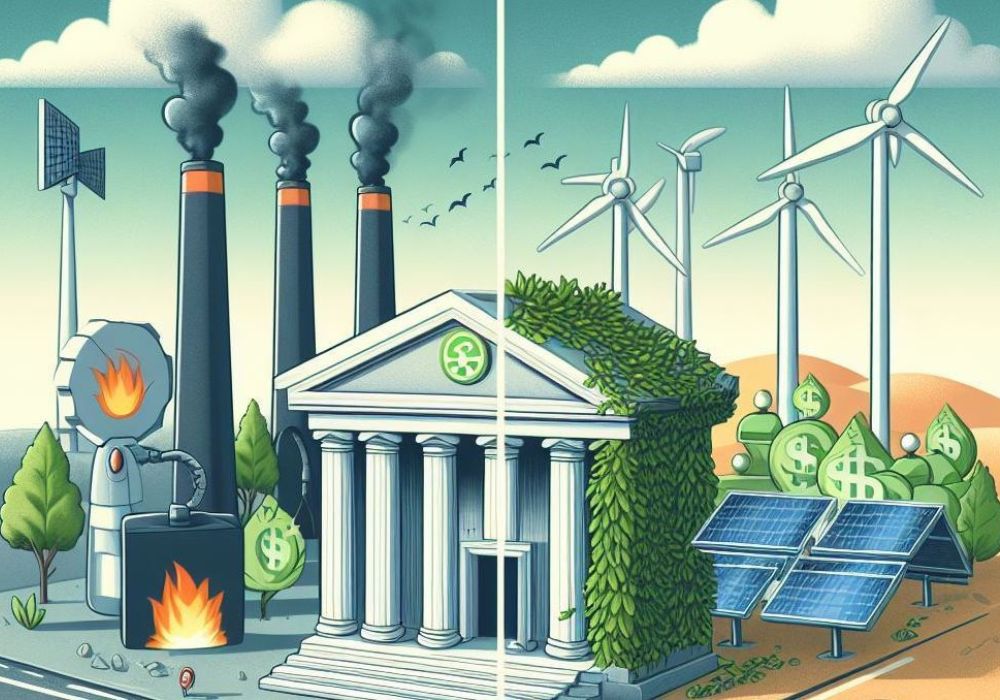Understanding Sustainable Banking Trends in Low-Growth Economies
The Concept of Sustainable Banking
Definition and Importance
Sustainable banking integrates environmental, social, and governance (ESG) factors into financial services. It ensures that banking activities support sustainable development goals.
This approach addresses climate change. It also promotes social equity and sound governance practices.
Key Principles of Sustainable Banking
Key principles include responsible lending, reducing environmental footprints, and promoting financial inclusion. They also include transparency and accountability in operations.
Sustainable banking aligns profit motives with positive societal impact. This ensures long-term viability and stakeholder trust.
Current Trends in Sustainable Banking Amid Low-Growth Challenges
Latest Developments in Sustainable Banking Strategies for 2024
In 2024, sustainable banking strategies are evolving rapidly. Banks are increasingly embedding sustainability into their core operations and offerings.
The focus is shifting towards comprehensive ESG integration. This impacts lending, investment decisions, and risk management frameworks.
Innovations in Green Finance
Sustainability-Linked Loans and Bonds
Sustainability-linked loans and bonds (SLL/Bs) tie financial terms to borrowers' sustainability performance. They incentivize improvements through measurable key performance indicators (KPIs). Sustainability-linked loans and bonds (SLL/Bs) allow borrowers to access more affordable financing against the condition they pursue and successfully achieve sufficiently ambitious and quantifiable environmental and social impact.
These instruments offer flexibility. They are not tied to specific projects but rather to overall sustainability achievements.
Blue Finance and Marine Conservation Investments
Blue finance is gaining traction. It channels funds towards ocean conservation and sustainable marine resource management.

Initiatives like blue bonds support projects in sustainable fisheries and marine ecosystem protection. They also support wastewater management and reducing ocean pollution. The ocean economy is projected to double to USD 3 trillion by 2030, generating employment for 40 million people.
Impact of Low-Growth Economies on Banking Practices
Analysis of Low-Growth Challenges for Banks
Low-growth economies pose unique challenges for banks. These include reduced lending opportunities and pressure on profitability.
Banks face decreased demand for credit. There are also heightened risks associated with prolonged economic stagnation.
The Role of Sustainable Banking in Economic Resilience
Sustainable banking can enhance resilience in low-growth environments. It diversifies revenue streams and fosters long-term stability.
By focusing on sustainable projects, banks can support economic transition. It also helps them mitigate risks associated with climate change and resource scarcity.
Addressing Challenges Facing Sustainable Banks
Key Challenges in Low-Growth Environments
Market Demand and Profitability Pressures
One of the primary challenges is balancing sustainability goals with profitability. In low-growth economies, market demand for green products may be limited.
Banks need innovative approaches. They need to stimulate demand and demonstrate the financial viability of sustainable investments.
Regulatory and Compliance Challenges
Navigating evolving regulatory landscapes is another hurdle. Compliance with emerging ESG standards requires significant investment in systems and expertise.
Banks must stay ahead of regulatory changes. They need to ensure they can adapt their operations and reporting accordingly. The European Union’s (EU’s) Corporate Sustainability Reporting Directive (CSRD) requires more than 50,000 public and private companies to disclose ESG factors starting next year.
Future Outlook for Sustainable Banking
Predictions for Sustainable Banking Strategies Post-2024
Beyond 2024, sustainable banking is expected to become more mainstream. Banks will further integrate ESG factors into their strategies and operations.
There will be a greater emphasis on impact measurement. Also, there will be transparency to meet stakeholder expectations.
The Role of Technology in Sustainable Banking Innovations
Technology will play a crucial role in driving sustainable banking innovations. Fintech solutions can enhance efficiency, transparency, and impact measurement.

Blockchain, for instance, can improve the traceability of sustainable investments. AI can help in assessing ESG risks and opportunities.
Leveraging Data for Impact Measurement
Data analytics will be essential for measuring the impact of sustainable banking initiatives. Banks will leverage data to track KPIs and demonstrate the effectiveness of their strategies.
Advanced analytics can provide insights into ESG performance. They can also help optimize sustainable finance products.
Building Partnerships for Sustainable Development
Collaborations with Environmental Organizations
Partnerships with environmental organizations and other stakeholders will be crucial. These collaborations can enhance the credibility and impact of sustainable banking initiatives.
Joint projects can drive innovation. They can also help in achieving shared sustainability goals.
The Influence of Gen Z on Sustainable Banking Practices
Gen Z's growing influence will shape sustainable banking practices. This demographic prioritizes sustainability and ethical considerations in their financial decisions.
Banks that align with Gen Z's values. They will attract and retain this important customer segment. Studies indicate that Gen Z is willing to pay more for products and services from companies committed to environmental sustainability.
Conclusion
Summary of Key Insights
Sustainable banking in low-growth economies presents both challenges and opportunities. Integrating ESG factors, leveraging technology, and building partnerships are key strategies for success.
The future of banking will be defined by how well institutions adapt to these trends. They must also meet the evolving expectations of stakeholders.
The Path Forward for Sustainable Banking
The path forward involves continuous innovation and collaboration. Banks must proactively address sustainability challenges and embed ESG principles into their core business models.
By doing so, they can drive positive change. They can also ensure long-term resilience and success in a rapidly changing world.
Key Takeaways:
- Sustainable banking integrates ESG factors into financial services, promoting responsible lending and environmental stewardship.
- Innovations like sustainability-linked loans and blue finance are expanding the scope of green finance.
- Low-growth economies pose challenges, but sustainable banking can enhance resilience and stability.
- Technology and data analytics are crucial for driving sustainable banking innovations and measuring impact.
- Partnerships and alignment with Gen Z values will shape the future of sustainable banking.
This comprehensive blog post integrates the latest trends in sustainable banking. It also includes SEO optimization and valuable insights for readers. It leverages internal links, such as Navigating the Latest Trends in Banking Regulatory Compliance: What You Need to Know, and external sources to enhance credibility and provide a thorough understanding of the topic.
